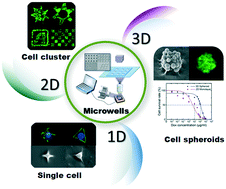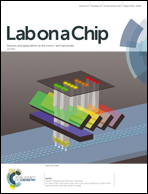Mask-free fabrication of a versatile microwell chip for multidimensional cellular analysis and drug screening†
Abstract
Cells are frequently studied because they are basic structural, functional, and biological units of living organisms. Extracting features from cellular behaviors can facilitate decision making in medical diagnoses and represents an important aspect in the development of biomedical engineering. Previous studies have just focused on either the individual cell or cell clusters separately, which leads to a great lack of information. Microwell technologies could address the challenges of in vitro cellular studies, from individual cell studies to 3D functional assays, by providing more information from smaller sample volumes and enabling the incorporation of low-cost high-throughput assays in the drug discovery process. To this end, the present study describes an easy-to-use method for fabricating a versatile microwell chip that utilizes a digital micro-mirror device printing system, and the chip can be employed in multidimensional cellular analysis, ranging from the single cell to the 3D spheroid level. The microwell manufacturing process, using a digital mask in place of a conventional physical mask, is based on shadowed light and is full of flexibility. Three different dimensions (single cell (1D), cell monolayer (2D) and cell spheroid (3D)) of one cell type can be formed using a microwell array and the analyses of biological characteristics are achieved separately. Single cells and cell clusters can be controlled via customized geometries of microfabricated selectively adhesive poly(ethylene glycol) diacrylate (PEGDA) wells. The effects of shape on cellular growth and hybrid tissue layers were investigated by peeling off the microwells. Furthermore, 3D multicellular spheroids were successfully established in a controllable and high-throughput format. Preclinical drug screening was investigated and distinct differences were observed in the tolerance response to drug testing between the 2D and 3D conditions. The study results further demonstrate that the high-density microwell chip is an easy-to-use multidimensional cellular analysis and rapid drug screening technique, and it could be easily adapted for a wide range of biological research applications.


 Please wait while we load your content...
Please wait while we load your content...